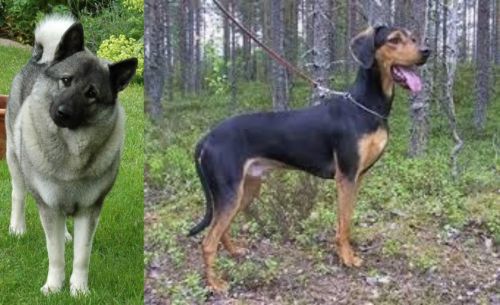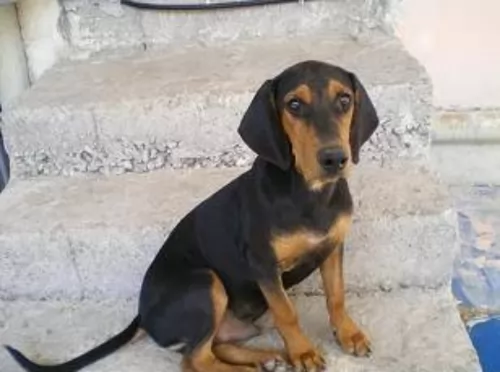 MyDogBreeds
MyDogBreeds Norwegian Elkhound is originated from Norway but Greek Harehound is originated from Greece. Both Norwegian Elkhound and Greek Harehound are of same height. Both Norwegian Elkhound and Greek Harehound are having almost same weight. Norwegian Elkhound may live 3 years more than Greek Harehound. Both Norwegian Elkhound and Greek Harehound has almost same litter size. Norwegian Elkhound requires Moderate maintenance. But Greek Harehound requires Low maintenance
Norwegian Elkhound is originated from Norway but Greek Harehound is originated from Greece. Both Norwegian Elkhound and Greek Harehound are of same height. Both Norwegian Elkhound and Greek Harehound are having almost same weight. Norwegian Elkhound may live 3 years more than Greek Harehound. Both Norwegian Elkhound and Greek Harehound has almost same litter size. Norwegian Elkhound requires Moderate maintenance. But Greek Harehound requires Low maintenance
 The Norwegian Elkhound is an ancient spitz-type dog breed hailing from Norway and with a history that goes back thousands of years.
The Norwegian Elkhound is an ancient spitz-type dog breed hailing from Norway and with a history that goes back thousands of years.
These dogs have been used as hunting dogs and have been able to bring down game such as Elk, bears, wolves, badgers and reindeer. They have also been used to guard livestock.
The Norwegian Elkhound was recognized by the American Kennel Club in 1913.
 Known also as the Hellenic Hound, the Greek Harehound is an ancient breed, and it is a dog which has come down through the ages with very little change to the way he looks.
Known also as the Hellenic Hound, the Greek Harehound is an ancient breed, and it is a dog which has come down through the ages with very little change to the way he looks.
The ancestors of the Greek Harehound go back thousands of years and are believed to be the ancient ‘Laconikoi’ dogs of the Peloponnese.
In was in 1996 that the Federation Cynologique Internationale recognized the Hellenic Hound. The Greek Harehound was also recognized by the United Kennel Club (UKC) in 2006.
 The Norwegian Elkhound is a medium to large sized dog standing at roughly 45 to 55cm in height and weighing anything fro 18 to 25 kilogams.
The Norwegian Elkhound is a medium to large sized dog standing at roughly 45 to 55cm in height and weighing anything fro 18 to 25 kilogams.
People love this dog because of his beautiful wolf-like face and bright eyes. The head is broad and wedge-shaped, the eyes dark brown, the ears stand erect and the bush tail curls over the dog's back.
The double coat has different shades of gray and silver with cream and white shades on the undercoat.
He is a moderate shedder with some seasonal shedding.
The Norwegian Elkhound is a high energy dog who loves to be busy and he also makes a loving and loyal companion towards his human family. He tends to be a little bit reserved around strangers.
He is an independent dog so so its a good idea to have him trained and socialized so that he is always obedient. He is an intelligent dog so you won’t battle to teach him.
He gets on well with children in the home. He however, can be a little bit aggressive with other dogs, but not if he was brought up with them as a puppy. Adventurous and active, he just loves spending time outdoors. It's why he is best suited to life in the countryside as opposed to the city and also prefers cooler climates.
 These dogs have a short, dense coat which is black and tan in color. He is a medium sized, well proportioned, deep chested dog standing at roughly 47 – 55cm in height and weighing between 17–20kg.
These dogs have a short, dense coat which is black and tan in color. He is a medium sized, well proportioned, deep chested dog standing at roughly 47 – 55cm in height and weighing between 17–20kg.
His legs are straight, well boned and strong. The skull of the dog is fairly flat, the eyes are brown while the ears are set high and are floppy. The tail is long, tapering down to a tip.
Lively and outgoing, the Greek Harehound is a skilled, brave hunter. These are active dogs and will require quite a bit of exercise if you get one as a pet. He becomes devoted to his owner, making a good, all-round family pet.
He has always been used in the past to hunt in packs so he gets on well with any other dogs in the family.
As a scenthound, the Greek Harehound is an independent, stubborn, strong-willed dog that will respond well to a firm, strong owner. His stubborn, strong-willed nature means it will be important to have him trained and socialized so that he becomes a well-rounded, obedient pet.
If you're looking for a true around-the-house family pet, this isn't the ideal choice as he is essentially a hunting dog, wanting to be running off on a hunt as opposed to lying quietly indoors. He is therefore better suited to life in the country than being cooped up in a small city property.
 Your Norwegian Elkhound makes an awesome pet. He is full of the joys of living and wants to be an active member of his human family.
Your Norwegian Elkhound makes an awesome pet. He is full of the joys of living and wants to be an active member of his human family.
He is active and always ready for some fun and games. He is also intelligent and will make an even better pet when he has been trained and socialized.
Those who have owned one of these beautiful dogs will always say how they adore this beautiful, smart, loving canine friend of theirs.
 Fast, courageous, smart, playful, independent and strong willed, the Greek Harehound is a slow maturing breed and he will require training and socialization to make him obedient and not so stubborn.
Fast, courageous, smart, playful, independent and strong willed, the Greek Harehound is a slow maturing breed and he will require training and socialization to make him obedient and not so stubborn.
Once trained he becomes a truly wonderful companion, being affectionate, loyal and outgoing. He makes a good friend of children too.
He is friendly and non-aggressive, though he still makes a good watchdog. He is a low maintenance pet too, and even though he is essentially a hunting dog, he can make anyone a splendid pet.
 Your beautiful Norwegian Elkhound can reach 15 years of age if you look after him well and he manages to avoid some of the common dog diseases there are.
Your beautiful Norwegian Elkhound can reach 15 years of age if you look after him well and he manages to avoid some of the common dog diseases there are.
There are some dog illnesses that are good to be aware of -
This is an eye condition where there is pressure that builds up in the eye. There is a problem with the drainage of fluid in the eye and this is what causes the pressure and there can be damage to the optic nerve.
This is a skin condition that causes inflammation and is often seen in dogs like the Norwegian Elkhound who have thick coats.
A common disease seen in many dog breeds, young and old, and which is a malfunction of the hip joints, causing problems with your dog’s mobility.
 The Greek Harehound is a healthy dog breed with no particular genetic defects. But like other dogs with floppy ears, they are more prone to infections and the insides of the ears will need to be cleaned frequently. Always do this with the utmost care to avoid damaging your pet's ears.
The Greek Harehound is a healthy dog breed with no particular genetic defects. But like other dogs with floppy ears, they are more prone to infections and the insides of the ears will need to be cleaned frequently. Always do this with the utmost care to avoid damaging your pet's ears.
He is a deep chested dog and this puts him at risk of gastric dilation and volvulus which is commonly referred to as bloat. Its a life threatening health issue where the stomach can twist. The stomach is sealed off as a result and gas builds up. The dog can go into organ failure.
 As a spitz type dog, the Norwegian Elkhound is an energetic dog who will need lots of physical activity.
As a spitz type dog, the Norwegian Elkhound is an energetic dog who will need lots of physical activity.
He has a very thick coat so make sure he doesn’t overheat during exercise as he has been used to living in wintry climates.
Your pet will shed some of that thick hair so he will need to be brushed at least twice a week to keep the coat in tip top condition. At the same time check him over for ticks and fleas. How often you see ticks on your dog will depend on where you live. These parasites attach to your dog and feed on his blood.They are capable of causing many diseases in your pet, one of which is Lyme disease, a disease which can lead to arthritis and swelling with your dog’s joints.
The best way to prevent any disease from weakening your pet is to get him to the vet as soon as possible. A good way to prevent ticks is to speak to your vet about tick control products.
Make sure he has the best food to ensure health and happiness. Keep his meals simple – no exotic, spicy foods that can upset his stomach.
A high quality kibble brand for energetic dogs is a wise choice and some tasty home-made food added in occasionally. This can be boiled chicken, brown rice and vegetables. Never leave him without a constant supply of fresh, cool water.
 The Greek Harehound is happiest when he senses he is free to follow scents and run. This is why this particular dog breed isn’t suited for life in the city where he has a small garden. He requires large pieces of ground to run free. If you own one of these dogs, he should be taken on daily walks and be involved in lots of sporting activities and games. If you’re a jogger or cyclist, this dog will be thrilled to join you.
The Greek Harehound is happiest when he senses he is free to follow scents and run. This is why this particular dog breed isn’t suited for life in the city where he has a small garden. He requires large pieces of ground to run free. If you own one of these dogs, he should be taken on daily walks and be involved in lots of sporting activities and games. If you’re a jogger or cyclist, this dog will be thrilled to join you.
Dog owners love that this dog is a low maintenance breed. The short coat simply requires a brush twice a week to rid him of loose hairs and to also keep his coat shiny and healthy.
Every new puppy will require a series of vaccinations in his first year to make sure he doesn't develop some of the serious dog diseases there are such as distemper, parvo-virus and rabies among others.
Dogs are carnivores and without human interference have always eaten fresh meat in the wilds. For convenience many people feed their dogs commercially manufactured food.
There are some excellent brands. Choose the best one for your pet and mix in raw meat from time to time as well as cooked rice, chicken and vegetables.
Never leave your pet without a constant supply of fresh, cool water.